Data is Knowledge, and Knowledge is Power.
Good data can help you make better business decisions. However, there can be a significant difference between the kinds of information that different data sets can provide. Data is definitely not “one size fits all”.
When you are doing market research, you need to make sure you are using the correct data for the situation at hand. That is why so many companies trust OpenBrand with their consumer durables research. It takes experience to determine the right data to use and expertise to uncover the insights you need for your unique business objectives.
High Quality Sources for Consumer Data
When it comes to consumer durables data sources, there are five major categories of data used in consumer research:
Internal Sales Data
Internal Sales Data is a high-quality source for digging into consumer insights and can be a great starting point for customer research. Even better, it is easy to use because internal sales data will be familiar to people within the organization.
Examples: YOY comp sales, sales by feature, pricing trends, promotional effectiveness, 10(K) / Earnings calls
Consumer Data
Custom research consumer data is a reliable source of data that will allow you to map consumer characteristics and behavior to purchases. It can be an excellent independent source to measure retailers or brands and competitors’ shares within consumer channels.
Examples: Customer satisfaction, preference tests, tradeoff analyses, segmentation
Point of Sale Data
Point of Sale (POS) data may be a part of your internal sales data, or you may be able to access collections from retailers, third-party companies, and manufacturers that partner with retailers. Comprehensive POS Data can be utilized to benefit marketing teams by indicating which features and SKUs are selling best and at which price point.
Examples: Category captain data and retailer POS extraction
Government Data
Government data is widely available and can provide a wealth of information about shipments, trade activity, business formation, patents, pricing, and economic trends. It is reliable in providing sales by retailer classifications, sales to non-residential construction, producer and consumer price indices, housing permits, housing starts, and completions.
Examples: Census data, Census of Retail Trade, CPI, Housing Starts/Completions, etc.
Industry Association Data
Sales data collected from member companies are typically collected and aggregated by trade organizations. Data includes the estimation of industry sales and may include breakdowns by revenue, geography, and other filters. This data is utilized when measuring sales in terms of shipments from manufacturers to their customers on a monthly or weekly basis.
Examples: OPE, AHAM, PCRP, RMA, HPBA, ISPA, PTI
Other sources for consumer data
While these sources are a good start, as you continue on your journey to collate and analyze data, there are other avenues to explore. Company websites, annual reports, and other business filings can be a resource of insight into industry and competitor performance. Some groups publish market research that is available for a fee. Other sources, like OpenBrand, may provide some market research reports online for free. You may begin monitoring social media as a source of data. However, it is important to be aware of the biases this can introduce (such as selection bias — not everyone is on social media).
Using the Right Data Sources for Market Research
In most cases, data diversity will be important. Single datasets can have gaps, blind spots, or biases. For example, if you are only using current customer feedback to assess product enhancements, you will not be able to tell if these enhancements will attract new customers — only the impact on existing customers.
It is also important to avoid data duplication. Even from different sources, some data can be present in multiple places and can skew results if you do not deduplicate it prior to analysis.
Using the right data tools, you can:
- Defend against competitive threats
- Find opportunities to build share
- Launch new products
- Track brand and retailer performance
- Track regional and national brands and retailers
- Learn about buyer motivations
- Prepare for line reviews
- Track online and offline shopping and buying trends
- Create custom research to make better decisions

Demystifying Consumer Data
It can be complex. That’s why businesses turn to OpenBrand solutions to provide the right data, using the right data sources, to provide consumer data and market insights. We track the entire retail market—both online and brick-and-mortar—across brands and outlets to provide a comprehensive market view. We can combine demographic, geographic, and behavioral data collected from the consumers that buy your products and provide up-to-date information on your industry and your biggest competitors.
Contact the data experts at OpenBrand today for more information on consumer research, market research, or to schedule a free demo. Let us show you how to demystify consumer data and how it can lead to insights that become powerful competitive advantages.
Related blogs
Unlock the Power of Real-Time Data & AI in Retail Success: White Paper
Have your data — and use it too. Accessing data in retail is one thing. Knowing what to do with it is another. Market data is not meant to…
Related blogs
3 Ways OpenBrand is Revolutionizing Retail Intelligence
In today’s hyper-competitive retail environment, actionable data is the lifeblood of strategic…
Home Depot vs. Lowe’s Earnings Call Reviews: Q4 2024 Market Intelligence
Earnings reports provide a valuable snapshot of a retailer’s financial performance, offering…
How to Leverage Competitive Pricing Intelligence to Stay Ahead of Tariffs and Market Volatility
Introduction: Why Competitive Pricing Intelligence Matters in an Uncertain Market For brands and…
Assortment Planning Analytics: Strategies, FAQs, & Best Practices
Staying ahead of the curve in today's fast-paced retail landscape is no small feat. There is…





